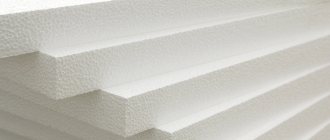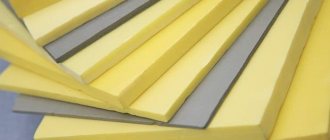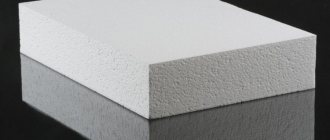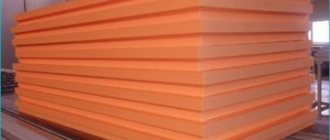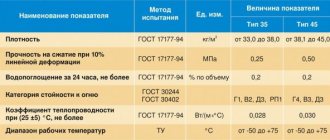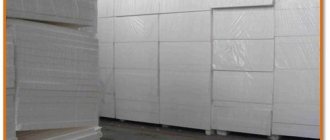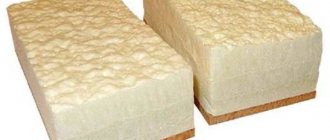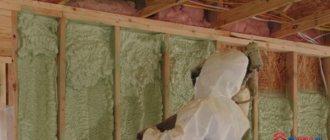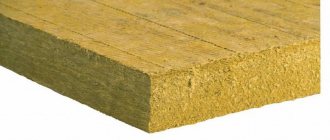If you are deciding which is better - polystyrene foam or polyurethane foam, you should compare properties these materials. In addition, it is necessary to take into account terms of Use, because in different rooms it may be preferable to use one or the other option. To conduct a full comparative analysis, the following factors are taken into account: structure, service life, strength and thermal insulation characteristics, hygroscopicity, noise absorption efficiency, density and some other parameters. The cost of the product is also important.
Briefly about 2 materials
Expanded polystyrene (EPS) is a gas-filled, closed-porous material based on polystyrene; its cells contain natural or carbon dioxide; there is also a vacuum version. There are 2 types:
- foamed;
- extruded (extruded).
Polyurethane foam (PPU) is a group of gas-filled plastics. The material is based on polyurethane. It can be rigid, elastic and self-foaming. If the characteristics of polyurethane foam and polystyrene foam are considered, you should know that both options are similar in most respects.
Buy PPU or PPS shells for pipe insulation
From us you can buy both PPU shells and PPS shells. First familiarize yourself with the characteristics of different brands of PPS shells.
If you type the following phrase into the search bar of your browser: “What is the difference between polystyrene foam and expanded polystyrene?” - then in the search results you will see many sites that all unanimously claim that polystyrene foam and polystyrene foam are absolutely two different materials. In fact, this is, of course, not true. The purpose of this article is to help understand what polystyrene foam is and what polystyrene foam is.
Comparative table of characteristics of polyurethane foam and polyethylene foam
These types of insulation are approximately equally popular, due to their properties. If you are interested in the question of polyurethane foam or polystyrene foam - which is better, it is recommended to compare them according to their main characteristics. The result can be seen in the table:
| Options | Polyurethane foam | Expanded polystyrene |
| Density, kg/m³ | 25-750 | 45-150 |
| Thermal conductivity coefficient, W/(m*K) | 0,019-0,028 | 0,04-0,06 |
| Structure | Closed-cell | Closed |
| Operating temperature, °C | -160…+180 | -100…+60 |
| Environmental friendliness | Polyurethane foam retains its properties and does not emit harmful substances when heated to the maximum value (+180°C). | Expanded polystyrene at a temperature of +60°C begins to release a compound dangerous to human health - phenol. |
| Duration of operation, years | With proper installation, the service life is unlimited, in other cases it is 50 years. | 42278 |
| Fire hazard | Incombustible | More susceptible to combustion. In high temperature conditions, burning areas can become separated, which contributes to the spread of fire. |
| Hygroscopicity | Does not absorb moisture. | It is more susceptible to liquids and is able to partially absorb them. |
| Appearance | Does not lose properties throughout the entire period of operation. | Over time, it shrinks and undergoes deformation due to loss of properties. |
Description of the properties of polyurethane foam
In the section Polyurethane foam - description, characteristics, we have already described polyurethane foam briefly. In everyday life, polyurethane foam is foam rubber; rigid construction grades are used to insulate walls, foundations, floors, roofs, and balconies.
Save up to 50% on heating
There are two ways to install polyurethane foam: sheets and spraying. Better insulation is created by spraying using GRACO high-pressure equipment. Ours uses exactly this equipment.
The main advantages of polyurethane foam
- thermal conductivity of polyurethane foam is 0.02 - 0.03 lower than that of polystyrene foam, and 2 times lower than that of mineral wool;
- high moisture resistance, practically does not absorb water;
- temperature of use of polyurethane foam from -70 to +110 degrees;
- the official service life is more than 30 years, there are known cases - 60 years, this is 5 times longer than that of expanded polystyrene and mineral wool;
- there is no deformation or subsidence during operation;
- he is not afraid of mold and mildew;
- good sound insulation;
- continuous seamless coating and foam-filled cracks, thanks to the spraying of fine foam;
- no condensation, which means no mold;
- good adhesion to any surface;
- there are no installation costs due to the lack of vapor barrier, wind protection, counter slats, you buy the installation and the insulation itself right away;
- low load on structures due to low weight;
- flexibility and elasticity under loads;
- the fastest installation compared to other insulation materials and without waste
- Our prices include the cost of installation and materials. See what everyday problems PPU solves for people here.
Disadvantages of polyurethane foam
- higher price, this disadvantage is compensated by savings of up to 50% on heating and cooling of premises, there are no drafts on the floor;
- protection from the sun is needed, polyurethane foam must be covered with paint or a decorative coating, for example, siding.
Comparison by cost
Protecting surfaces with polyurethane foam insulation is a more expensive technology. So, thermal insulation of 1 m² will cost 150-1500 rubles. In this case, the price is formed taking into account the thickness of the material: from 10 to 100 mm. This means that in order to insulate a surface of 1 m² with a 50 mm thick layer of polyurethane foam, you need to prepare about 850 rubles. The high price of this type of thermal insulation is due not only to the production technology of the material, but also to the high cost of the equipment.
If you are deciding which is better - polyurethane foam or polystyrene foam, you should know that the latter option is offered at a lower cost. For comparison, insulating an area of 1 m² with EPS boards will cost several times less - 300 rubles, provided that the thickness is 50 mm. Good polystyrene foam boards, characterized by large dimensions and high density, are more expensive.
Which is better - polystyrene foam or polyurethane foam
The final choice
Many people are interested in what is better – polyurethane foam or polystyrene foam. Based on the results of considering the two materials, we can say that in comparison polyurethane foam is much more effective. However, it may not be suitable for some due to its high cost. Expanded polystyrene is much cheaper, but in the future it can bring large costs. After all, the service life is 2 or even 3 times less than that of a competitor.
Important! The choice is made based on your own requirements for the material and its properties. Only a very responsible approach to the selection of material will allow you not to grieve about wasted funds.
The difference between polyurethane foam and expanded polystyrene is the level of reliability and its feasibility.
Insulation of a garage or small house can be done using polystyrene foam. It is cheaper, and for such buildings the resource will be quite sufficient. Extruded polystyrene foam will cost a little more, but it will slightly improve the quality of insulation.
For your own apartment or residential building, it is logical to choose high-quality polyurethane foam. Yes, it is much more expensive. But over time, it will not upset the owner and will serve faithfully for the entire period.
For what purposes is it better to use?
PPU and PPS have their own advantages over each other; for this reason, in some conditions it is preferable to use one or another insulation option. For example, it is better to use PPU if the following tasks arise:
- it is necessary to create effective wind protection;
- it is necessary to realize the requirement of high adhesion;
- creation of a seamless thermal insulation structure;
- short installation time.
When polyurethane foam and polystyrene foam are considered, the comparison is made not only in terms of parameters, but also in terms of operating conditions. For example, if you plan to use EPS, it is necessary to ensure high-quality moisture protection, which is facilitated by film materials. Expanded polystyrene and structurally similar analogues (foam plastic) need to create conditions in which the risk of fire will be low.
What to choose?
So what is better to order? After all, the difference between polyurethane foam and expanded polystyrene is not so fundamental. Both materials have similar performance characteristics. If we compare polystyrene foam and polyurethane foam according to individual parameters, it is also unlikely that we will be able to identify the absolute leader. In some cases the difference will not be significant. For example, both materials are characterized by good water resistance and a wide temperature range in which they can be used. However, there is a difference between polystyrene foam and polyurethane foam. In terms of durability, ease of installation and environmental friendliness, the first material has clear advantages. Yes, it is inferior in terms of thermal protection, but one cannot say that it is very significant.
What else is different from polyurethane foam? Because it is not at all afraid of exposure to ultraviolet rays, and therefore it can be used to insulate the roof. Perhaps their main difference is the price. The cost of extruded polystyrene foam is significantly lower.
We bring to your attention a table comparing thermal insulation materials such as polystyrene foam (EPS) and polyurethane foam (PUF), which are used in the manufacture of thermal panels
Comparison of thermal panels made of polystyrene foam (EPS) and polyurethane foam (PPU)
| Expanded polystyrene | Polyurethane foam |
| Environmental friendliness | |
| When heated to 60 degrees, it releases phenol | Complies with sanitary standards and regulations; the products have a sanitary and epidemiological certificate. Can be used at temperatures up to 180 degrees |
| Fire hazard | |
| Flammable | Does not support combustion |
| Durability | |
| The material shrinks and contracts, which can lead to changes in the geometry of the façade. | UV-protected polyurethane foam is resistant to most solvents, and its service life exceeds the service life of the building’s load-bearing structures. |
| Limited service life. Significant decrease in performance after 10 years of use. | Does not change properties throughout the entire service life |
| Appearance | |
| Deep joints lead to greater consumption of expensive joint fillers. | Perfect joining of panels, precise adherence to masonry geometry throughout the entire façade |
| The choice of materials is limited, because a special dovetail tile shape is required | Possibility of using facing materials of any shape. |
| Ease of installation | |
| The softness of the supporting base and the weak fastening of the tiles to the panel lead to large waste of material during transportation and installation. | The rigidity of the material means the possibility of cladding without the use of sheathing. |
| The tile is held in place only by the recesses in the tile (dovetail); when cutting and installing, individual tiles fall out of the panel and must be glued back in | The tile is securely held in the panel due to adhesion. Cutting panels does not cause tiles to fall out. |
| The use of thick tiles (13-17 mm) increases the weight of the panels | Less weight of the panel due to the ability to use tiles of smaller thickness (8-11 mm) |
| Building materials do not adhere well to polystyrene foam; expensive special mixtures are required to fill the joints. | Quartz sand in the seams increases the strength of the panel and increases the adhesion of the jointing in the seams. |
| Features of operation | |
| Excessive humidity can lead to fungal infection and create an unfavorable indoor microclimate | Polyurethane foam insulation is resistant to fungi, mold and bacteria. For many years, polyurethane foam has proven itself to be an excellent insulating material that is safe for health and does not have a harmful effect on the natural environment. |
| When moisture gets in and freezes, the foam is destroyed. | The use of thermal panels provides reliable waterproofing and vapor barrier, which reduces the cost of using additional insulation and insulation materials. |
| Regular inspection of the façade and elimination of any defects required | Does not require renovation or repair during the entire service life of the building. The components do not support combustion and are difficult to combust. |
A couple of reviews about EPPS
Leonid, 35 years old, Omsk: Used polystyrene foam to insulate the walls of a residential dacha. The house is small and heated in winter, so there were no problems with the appearance of moisture inside the insulating “pie”. I carry out repairs every 5-7 years, which means that during this time the insulation will not have time to sag and lose its qualities.
Vitaly, 45 years old, Khabarovsk: Expanded polystyrene does not weigh down the structure and retains heat well, so I chose this material. I heard that it is flammable, but the house uses a minimal amount of fire-hazardous coatings, for the most part concrete, brick, plastic, and metal are used everywhere.
Advantages and disadvantages of expanded polystyrene
Ordinary polystyrene foam absorbs moisture relatively well, so you should use an adhesive with a higher density. Expanded polystyrene is a common foam plastic that everyone is familiar with. It has been used for several years now and all its pros and cons have long been known. At its core, it is 98% air bubbles enclosed in 2% polystyrene.
There are two types of expanded polystyrene - regular (foamed) and extruded. Due to its higher density, the latter has better thermophysical properties, it is stronger and more durable.
Both types of foam are available in the form of slabs of various thicknesses. How to distinguish one from the other? Try breaking off a piece from the edge of the slab. Cheap, packing foam will have small balls along the break. High-quality, extruded polystyrene foam will show regular polyhedra when broken.
The main advantages of polystyrene foam include the following:
The advantages of extruded polystyrene foam compared to conventional polystyrene foam are:
Note:
Insulation of premises with polystyrene from the inside is prohibited. Moisture (condensation) accumulates very quickly between the insulation and the walls, which leads to fungal infection and accelerated destruction of the building.
Among the disadvantages, the following should be noted:
- water-absorbing properties of ordinary polystyrene foam - wet polystyrene foam reduces its thermal insulation properties and quickly becomes unusable;
- short service life - only 10-15 years;
- rodents often make their nests in it;
- destruction under the influence of external factors - the slightest exposure to sunlight through poor-quality plaster begins to destroy the insulation;
- deformation during use;
- fire hazard - burns well; when burned, a fairly large amount of toxic substances is released.
Note:
already at 60 degrees, polystyrene foam is susceptible to decay, so it is not worth using it for roof insulation. In the summer in the southern regions, the roof can easily heat up to 100 degrees.
A couple of reviews about PPU
Valentin, 31 years old, Perm: I rented equipment for spraying polyurethane foam. The attic needed to be insulated. I made the thermal insulation of a small thickness (20 mm), but the result is already visible - heat is retained much better in the room.
Petr, 39 years old, Orel: Most surfaces in the house are insulated with polyurethane foam. This material suits all parameters. Insulation is more expensive, but the structure will last longer.
Introduction
As already mentioned, most people completely do not understand the meaning of the words polystyrene foam and polystyrene foam. Some particularly advanced ones may add the word extruded or extruded foam and combine these words at their discretion. Others believe that regular polystyrene foam is polystyrene foam, and extruded polystyrene foam is expanded polystyrene. Still others completely confuse all these words. Looks like we're about to get confused too...
Oddly enough, all these people are partly right. But let's take things in order.
Foam plastic is a whole class of materials used in mechanical engineering, healthcare, gardening, of course - in construction and even in beekeeping, as well as in some other industries. The foam is based on ultra-light plastic gas-filled plastics obtained from various synthetic polymers. The name of a specific type of foam is determined depending on what polymer or resin the material is made from.
Here is just one of the classifications of polystyrene foam - according to the type of polymer or resin used:
- alkene foams - made from polyethylene and polypropylene;
- urea foams - made from urea-formaldehyde resins (Penoizol);
- polyvinyl chloride foams - made from polyvinyl chloride resins;
- polystyrene foams - made from expanding polystyrene with or without the addition of a fire retardant (expanded polystyrene, extruded polystyrene foam);
- polyurethane foams - made from polyesters and polyisocyanates with the addition of a fire retardant (polyurethane foam insulation);
- Phenolic foams - made from resol or novolac phenol-formaldehyde resins and phenolic alcohols.
Thus, polystyrene foam is a general term for foamed plastics, and polystyrene foam is one of the types of foam plastic. Therefore, to say that polystyrene foam and expanded polystyrene are the same thing is tantamount to saying that a UAZ car and the word car itself are one and the same, or that a rose and a plant are one and the same. UAZ is a car brand, rose is the name of a type of plant, and polystyrene foam is one of the types of foam plastics, just like polyurethane foam and Penoizol.
All types of foam plastic have a low thermal conductivity coefficient and, as a result, have excellent thermal insulation qualities, which is why they are very often used for wall insulation.
Almost all foam plastics release very toxic substances during combustion. Therefore, their applicability in the construction of residential buildings imposes certain restrictions on design documentation.
Comparison
Each of the materials mentioned has its own properties. First, let's touch on the most significant characteristic - thermal conductivity. In this regard, the advantage of polyurethane foam is noted. Moreover, it is important that it is produced not only in the form of panels, but also as an aerosol product that is sprayed onto objects. If polyurethane foam is used in this way, a monolithic coating is obtained that exactly follows the topography of the base.
Expanded polystyrene does not require such an effective application method. It is mounted to the surface in the form of solid slabs. The gaps between them cause heat leakage and deterioration of sound insulation. The difference between polystyrene foam and polyurethane foam is that it does not interact well with adhesives and plaster compositions. Meanwhile, polyurethane foam can be firmly fixed to the surface. In addition, this material absorbs moisture less, which has a positive effect on heat conservation.
It is worth noting that polystyrene foam begins to disintegrate and release hazardous substances at a lower temperature - approximately sixty degrees Celsius. Therefore, it is not recommended to insulate the roof with it, especially in the southern regions with the scorching sun. As for the fire safety indicator, the materials discussed themselves do not burn for a long time. But if there is a constant source of fire, then polystyrene foam quickly becomes engulfed in flames. The process is accompanied by the separation of melting fragments and the saturation of the air with a large amount of toxins. The second material burns worse.
What is the difference between polystyrene foam and polyurethane foam regarding their service life? Here the second type of product wins again. Polyurethane foam retains its beneficial qualities much longer. This is partly due to the fact that it is not subject to deformation. Expanded polystyrene is compressed over time, and its thermal insulation properties noticeably deteriorate. As a result, polyurethane foam is the leader in all respects. It is not surprising that the price is higher.
Roof insulation is a process that automatically converts an attic space from non-residential to residential. At the same time, the housing area increases almost by the size of a full floor, and such an increase should not be neglected. Insulating your attic roof will help you create another living space without much effort.
It is worth mentioning other good reasons for insulating the roof - for example, eliminating its heating in winter, which eliminates the formation of ice, icicles, and, on warmer days, snow falling off the roof. Thus, the procedure is necessary and useful. You can read more about insulating your roof yourself in this article.
Polyurethane foam (PPU) is deservedly considered one of the most effective insulation materials.
.
Let's look at roof insulation with polyurethane in more detail.
Application area
Expanded polystyrene, or polystyrene foam, is used in various fields of activity: from electronics packaging to individual construction. Foam plastic, as a building material, has become widespread for all types of thermal insulation work:
- it is used for roof insulation. The simplicity and ease of its installation makes it possible to carry out work in any weather conditions. In addition, expanded polystyrene is used for the reconstruction of flat roofs;
- expanded polystyrene slabs are used for floor insulation in houses; this is not only good thermal insulation, but also waterproofing;
- polystyrene foam is used as insulation for heated floors, which significantly reduces costs;
- This material can be used to insulate the walls of buildings, both outside and inside; it can be used to insulate loggias and balconies;
- expanded polystyrene has become widespread not only for internal insulation of a house: it is used for thermal insulation of the foundations of buildings and pipelines.
But not only polystyrene foam has become so widespread in construction; along with it, polyurethane foam is also in great demand. It is easy to use, and its main feature is that this heat-insulating material is not presented in the form of plates and rolls, as usual, but in the form of a special composition that is sprayed onto the surface. This feature makes polyurethane foam a universal insulation material, which has led to its widespread use in construction, where polyurethane foam is used in various directions:
- due to the chemical resistance of this material, it is well suited for thermal insulation of containers, such as swimming pools;
- polyurethane foam is excellent for because it has a high reaction rate, which avoids foam dripping;
- the adhesive properties of this material make it possible to widely use polyurethane foam for insulating the foundations of buildings;
- it is used for thermal insulation of the roof;
- this material is excellent for insulating the walls of buildings, both outside and inside.
Polyurethane foam and polyurethane foam are similar in many ways, but they are still two different materials with different properties.
